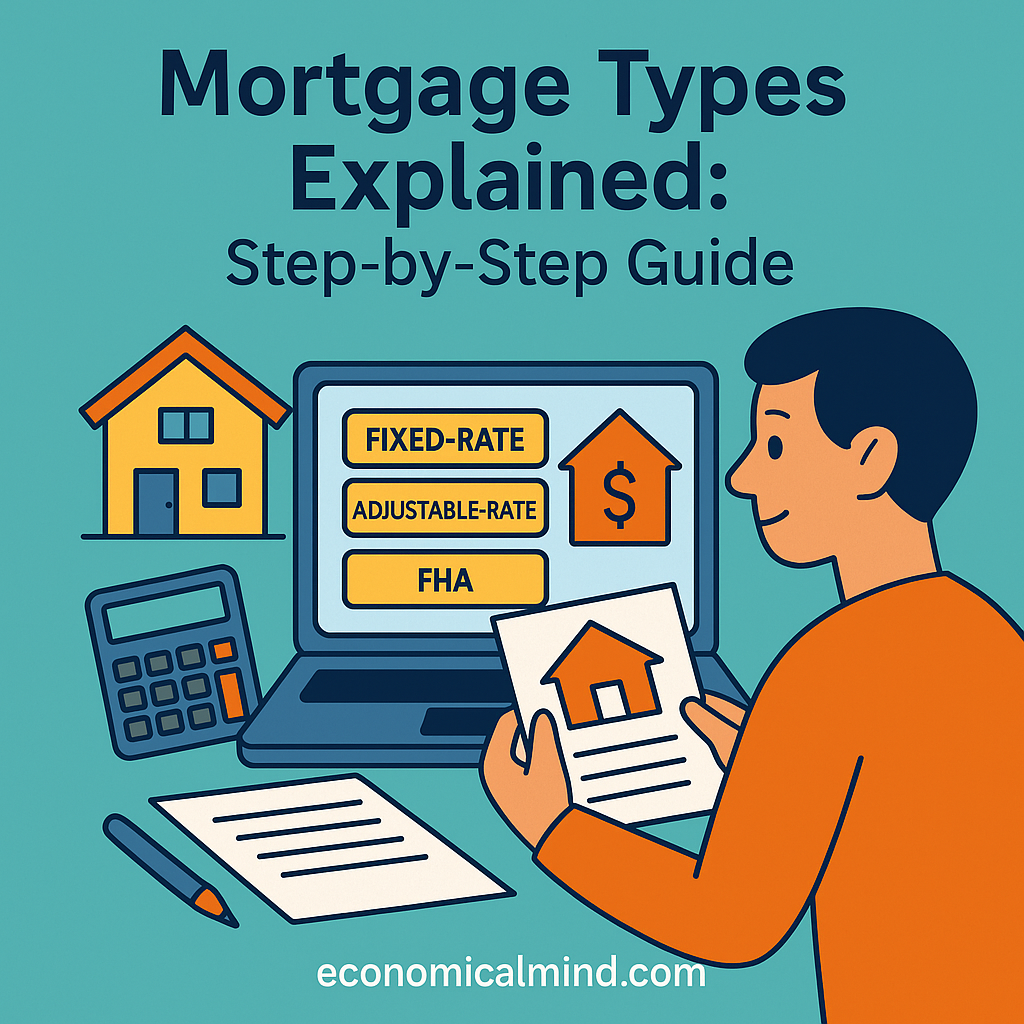
Why Understanding Mortgage Types Matters
Buying a home is one of the biggest financial decisions you’ll ever make — and your mortgage type can determine how much you pay over time.
From interest rates to loan terms, each mortgage has pros and cons that fit different budgets and goals.
By understanding your options, you can choose the loan that keeps your payments stable and your stress low.
Step 1: Know the Two Main Categories
Mortgages fall into two major groups: fixed-rate and adjustable-rate loans.
Each affects your monthly payments differently.
- Fixed-Rate Mortgage (FRM):
Your interest rate stays the same for the entire loan term — typically 15, 20, or 30 years.
✔ Predictable payments
✔ Easier budgeting
✖ Slightly higher initial rate - Adjustable-Rate Mortgage (ARM):
Starts with a lower rate that adjusts periodically (often every 1–5 years).
✔ Lower starting payments
✔ Good for short-term homeowners
✖ Risk of future rate increases
If you plan to stay in your home long-term, a fixed-rate loan offers peace of mind. If you expect to move within a few years, an ARM might save you money upfront.
Step 2: Learn About Conventional vs. Government-Backed Loans
Mortgages can also be classified as conventional or government-backed:
- Conventional Loans:
Not insured by the government. Best for buyers with solid credit and down payments of at least 3–20%. - Government-Backed Loans:
Designed for specific needs and offer lower requirements:- FHA loans: For first-time buyers, 3.5% down, flexible credit.
- VA loans: For veterans and military families, often 0% down.
- USDA loans: For rural buyers, 0% down and income-based approval.
These programs make homeownership more accessible for buyers with lower credit or limited savings.
Step 3: Compare Loan Terms
Your loan term determines how long you’ll make payments and how much interest you’ll pay overall.
Common options:
- 30-year mortgage: Lower monthly payments, higher total interest.
- 15-year mortgage: Higher payments, less interest over time.
- 20-year mortgage: A balance between the two.
If you can afford higher monthly payments, shorter terms help you build equity faster and save thousands in interest.
Step 4: Understand Jumbo and Conforming Loans
The amount you borrow also affects your loan type.
- Conforming loans: Meet the borrowing limits set by Fannie Mae and Freddie Mac (around $766,550 for 2025, depending on location).
- Jumbo loans: For amounts above those limits — used for expensive homes.
- Require higher credit scores (700+)
- Often larger down payments
- May have stricter income verification
If your dream home is in a high-cost area, a jumbo loan might be your only option — but expect tighter approval standards.
Step 5: Understand Interest Rate Factors
Your interest rate determines how much you pay over time. Lenders base it on:
- Credit score
- Down payment size
- Loan type and term
- Market rates at the time
Pro tip: A small rate difference — even 0.25% — can mean thousands saved or lost over a 30-year mortgage.
Step 6: Consider Mortgage Insurance
If you put down less than 20% on a conventional loan, you’ll likely pay Private Mortgage Insurance (PMI).
It protects the lender (not you) if you default on payments.
You can remove PMI once you reach 20% equity in your home.
For FHA loans, mortgage insurance is required for the life of the loan unless you refinance later.
Step 7: Get Preapproved Before Shopping
A mortgage preapproval gives you a clear picture of what you can afford and makes you a stronger buyer.
During preapproval, a lender reviews your:
- Credit score
- Debt-to-income ratio (DTI)
- Employment history
- Savings and down payment
This helps you compare real offers — not just estimates — and negotiate better deals with sellers.
Bonus Tip: Shop Around
Never settle for the first lender you find.
Compare at least 3–5 mortgage offers — even a small rate difference can save tens of thousands over time.
Use free tools like LendingTree, Bankrate, or NerdWallet to compare rates side-by-side.
Final Thoughts
Understanding mortgage types empowers you to make confident decisions when buying a home.
Whether you choose a fixed-rate, FHA, or jumbo loan, the best mortgage is the one that fits your goals, budget, and long-term plans.
When in doubt, talk to a licensed loan officer who can walk you through the details before you sign.
